What You Will Learn
All manufacturing industries, research and development organizations, and design divisions of major corporations hire drafters, as well as architects, designers and engineers in the preparation of various stages of formal drawings. Plus, demand for drafting jobs is expected to continue to grow through the next decade. The Computer-Aided Drafting (CAD) Technology Program at CCM prepares a person for an entry-level position as a junior drafter, drafter trainee, or drafter using CAD.
Since CAD is dependent upon the latest software, it is important for operators to stay current with developing technologies and techniques. Familiarity with the latest CAD systems increases your ability to gain employment. Completion of the supportive coursework in manufacturing, materials, science, mathematics and writing enables you to continue advancing in your career.
Many students in the CAD program continue at CCM to earn their Associate in Applied Science (AAS) in the Mechanical Engineering Technology Program.
Curriculum
18-22 credit core provides the training to become proficient in CAD and learn other computer applications, materials and manufacturing processes for engineering technology, electronics fabrication and an intro to experimentation and design.
Careers in the Field
With a certificate of achievement in CAD, you can be equipped for the following positions:
- Architectural Drafters
- Computer-Aided Designer/Drafter/Engineer
- Electrical Drafters
- Mechanical Drafters
and work in fields such as:
- Aeronautics
- Architecture
- Civil engineering
- Electronics
- Mechanics
- Process Pipelines
CAD salaries vary depending upon the drafting specialty.
According to the U.S. Bureau of Labor Statistics, mechanical drafters earned a median annual salary of $60,400 in 2022, while architectural and civil drafters had a median pay of $59,820.
Most CAD operators in 2021 earned between $40,000-$77,000, according to Payscale.
Why Study Computer-Aided Drafting at CCM
- Be confident that you are prepared for an entry-level position as a Junior Drafter, Drafter Trainee, or Drafter using computer-aided drafting (CAD).
- Small class sizes enable individual attention from faculty with industry experience who deliver a real-world understanding of the field.
- Gain an increase in technical skills and knowledge base within the manufacturing, materials, science, mathematics and writing to advance your career.
- Use state-of-the-art computers running the latest version of computer aided drafting and design (CADD) software to aid in your hands-on CCM education.
- Learn in a fully-functional prototyping lab rounding out your experience in the manufacturing process, taking ideas from concept to reality.
- Team based learning provide the perfect opportunity to successfully solve real-world problems.
- This program is available through on-campus learning between lectures and laboratory for a better experience within the trade.
Paying For Your Computer-Aided Drafting Education
Earning a certificate of achievement from CCM is a powerful investment that is a springboard to both increased earnings and job satisfaction. But what is the upfront cost and how do you afford it?
There’s good news: Money is available to help you pay for school! Our Financial Aid staff can provide lots of information about the process of finding funds to help pay for your CCM education.
In addition, Glenbrook Technologies, NDIA John Amerspek, NDIA Rodney Frelinghuysen and NDIA Dean Gallo offer scholarships. Please contact the Department of Engineering Technology and Engineering Science for more information.
Featured Courses
Computer-Aided Drafting (CAD) I & II
Learn the concepts and operation of engineering drawing preparation in this lecture and laboratory in this four-credit, two-semester course. Become proficient in AutoCAD to aid in reducing drawing time and improve accuracy. Additional topics include prototype drawings, blocks, attributes, x-reference, grips, paper space and development of 3-dimensional solid modeling.
Materials for Engineering Technology
Focusing on metallic, plastic and ceramic materials that are important to manufacturing, learn about molecular and microscopic structures in relationship to material properties, testing of mechanical and thermal properties with reference to ASTM standards, equilibrium diagrams and physical metallurgy emphasizing steel and aluminum, heat treatment of steel, molding and forming methods for plastics. A brief study of ceramics and composites is included.
Computer Technology Applications
This general education course teaches you: (1) basic computer-use concepts such as hardware and peripherals, file organization and management, and operating system use; (2) Internet use, browsers and search engines; (3) software applications including word processing, spreadsheet, electronic slideshow presentations, database use and calendaring; (4) netiquette, ethics and copyright policies; (5) downloading and installing software and plug-ins; (6) communications technologies including email, blogs and Web technologies; (7) personal computer and information security; and (8) career exploration, job search strategies and portfolio development.
Resources
Your Computer-Aided Drafting Faculty Advisors
Assistant Professor
Assistant Professor
Department Chairperson, Associate Professor
Assistant Professor






